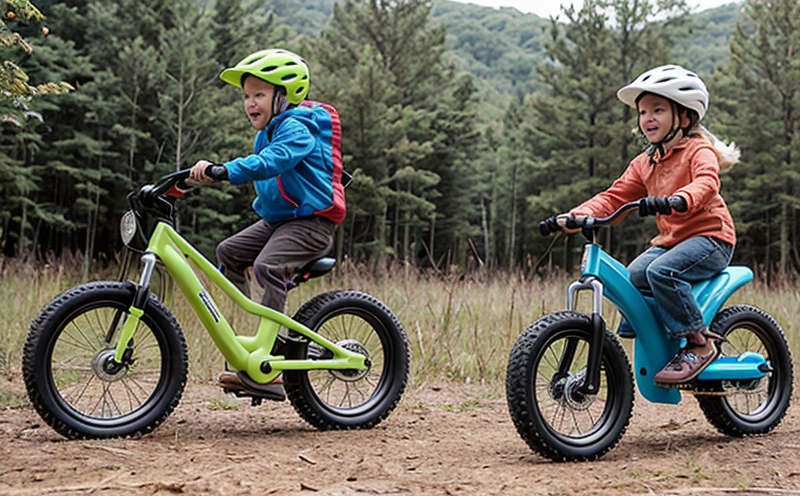ASTM F963 Ride-on Toy Forward and Reverse Motion Safety
The ASTM F963-17 Standard Consumer Safety Specification for Toy Safety is one of the most comprehensive toy safety standards in the world. It covers a wide range of potential hazards that could be present in toys, including mechanical hazards such as sharp edges or small parts that can pose choking risks to children.
One specific aspect of this standard pertains to ride-on toys and outdoor equipment. These products often involve significant forward and reverse motion, which means they must undergo rigorous testing to ensure the safety of young users. The ASTM F963 Ride-on Toy Forward and Reverse Motion Safety test evaluates whether these toys are safe for use in both forward and reverse motions.
During this test, ride-on toys are subjected to various mechanical stressors designed to mimic real-world usage conditions. This ensures that the toy can withstand the forces exerted by children during play without causing injury or damage. The goal is to identify any potential hazards associated with the forward and backward motion of these toys.
For instance, a child might accidentally reverse the direction of an electric ride-on vehicle while playing, leading to unexpected movement that could result in injury if not properly tested beforehand. By conducting this test according to ASTM F963 guidelines, manufacturers can guarantee that their products meet industry standards for safety and are fit for use by children.
In addition to physical testing, there are also other considerations when evaluating ride-on toys' forward and reverse motion safety. These include ensuring proper labeling on the product packaging regarding age appropriateness, warning labels about potential hazards, and instructions for safe usage. Compliance with these requirements helps protect consumers from unforeseen risks while still allowing innovation within the toy manufacturing sector.
Understanding the nuances of ASTM F963-17 can help ensure compliance throughout all stages of product development—from design through final assembly. Familiarity with relevant sections allows manufacturers to anticipate necessary adjustments early on in the process, reducing costly rework later down the line.
To summarize, ASTM F963 Ride-on Toy Forward and Reverse Motion Safety is a critical component of overall toy safety testing that focuses specifically on mechanical hazards related to motion. By adhering to this standard during design and manufacturing processes, companies can produce safer products while maintaining high levels of quality and performance expectations.
Applied Standards
| Standard Number | Title | Date Released |
|---|---|---|
| ASTM F963-17 | Standard Consumer Safety Specification for Toy Safety | September 1, 2017 |
The ASTM F963-17 standard is the primary reference document used in our testing process. It provides detailed instructions on how to conduct various types of toy safety tests, including those related to ride-on toys and outdoor equipment.
| Test Parameter | Description |
|---|---|
| Forward Motion Test | This test assesses the stability of a toy during forward movement. It ensures that the toy does not tip over or become unstable when pushed at various speeds. |
| Reverse Motion Test | The reverse motion test evaluates how well a toy maintains control and stops safely when reversed. This helps identify any potential risks associated with sudden direction changes. |
| Impact Testing | Impact testing simulates collisions that may occur during normal play. It checks for structural integrity and prevents parts from breaking off or becoming detached. |
These tests are crucial in ensuring the safety of ride-on toys and outdoor equipment, particularly regarding their forward and reverse motion capabilities. By adhering strictly to ASTM F963 guidelines, we can provide accurate results that meet regulatory requirements and industry best practices.
Scope and Methodology
The scope of the ASTM F963 Ride-on Toy Forward and Reverse Motion Safety test includes evaluating various aspects of ride-on toys and outdoor equipment to ensure they are safe for use in both forward and reverse motions. This involves several key steps:
Preparation: Before testing begins, each toy must be thoroughly inspected to confirm it meets the basic requirements specified by ASTM F963.
Forward Motion Test: The toy is placed on a flat surface and gently pushed forward at different speeds. Observations are made regarding stability, noise levels, and any vibrations or unusual noises produced during movement.
Reverse Motion Test: Similar to the forward motion test, but with the direction reversed. Attention is paid to how easily the toy can be stopped and whether there are any signs of wear or damage after reversing multiple times.
Impact Testing: To simulate real-world scenarios where a child might accidentally bump into something while using the toy, impact tests are performed on various parts of the vehicle. The results help determine if any components become loose or break under these conditions.
Evaluation and Reporting: After completing all tests, an evaluation is conducted to assess whether the toy complies with ASTM F963 standards. A detailed report summarizing findings and recommendations for improvement (if necessary) is then prepared.
Throughout this process, strict adherence to ASTM F963 procedures ensures that every aspect of the ride-on toy or outdoor equipment undergoes thorough examination before being declared safe for use by children.
Benefits
Ensures compliance with international toy safety standards like ASTM F963-17.
Reduces the risk of recalls or product liability issues by identifying potential hazards early in the design phase.
Provides valuable insights into how toys perform under realistic conditions, helping manufacturers improve their designs and enhance user experience.
Increases customer trust and satisfaction through consistent quality control measures that meet high industry standards.
By leveraging ASTM F963 Ride-on Toy Forward and Reverse Motion Safety testing, companies can safeguard against legal risks associated with non-compliance while simultaneously enhancing their reputation as leaders in child safety and product excellence.





